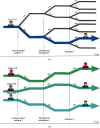Reinforcement Learning in Neurocritical and Neurosurgical Care: Principles and Possible Applications
- PMID: 33680069
- PMCID: PMC7925047
- DOI: 10.1155/2021/6657119
Reinforcement Learning in Neurocritical and Neurosurgical Care: Principles and Possible Applications
Abstract
Dynamic decision-making was essential in the clinical care of surgical patients. Reinforcement learning (RL) algorithm is a computational method to find sequential optimal decisions among multiple suboptimal options. This review is aimed at introducing RL's basic concepts, including three basic components: the state, the action, and the reward. Most medical studies using reinforcement learning methods were trained on a fixed observational dataset. This paper also reviews the literature of existing practical applications using reinforcement learning methods, which can be further categorized as a statistical RL study and a computational RL study. The review proposes several potential aspects where reinforcement learning can be applied in neurocritical and neurosurgical care. These include sequential treatment strategies of intracranial tumors and traumatic brain injury and intraoperative endoscope motion control. Several limitations of reinforcement learning are representations of basic components, the positivity violation, and validation methods.
Copyright © 2021 Ying Liu et al.
Conflict of interest statement
The authors declare that they have no conflicts of interest.
Figures



Similar articles
-
Inverse reinforcement learning for intelligent mechanical ventilation and sedative dosing in intensive care units.BMC Med Inform Decis Mak. 2019 Apr 9;19(Suppl 2):57. doi: 10.1186/s12911-019-0763-6. BMC Med Inform Decis Mak. 2019. PMID: 30961594 Free PMC article.
-
Reinforcement Learning for Clinical Decision Support in Critical Care: Comprehensive Review.J Med Internet Res. 2020 Jul 20;22(7):e18477. doi: 10.2196/18477. J Med Internet Res. 2020. PMID: 32706670 Free PMC article. Review.
-
Incorporating causal factors into reinforcement learning for dynamic treatment regimes in HIV.BMC Med Inform Decis Mak. 2019 Apr 9;19(Suppl 2):60. doi: 10.1186/s12911-019-0755-6. BMC Med Inform Decis Mak. 2019. PMID: 30961606 Free PMC article.
-
Reinforcement learning and its connections with neuroscience and psychology.Neural Netw. 2022 Jan;145:271-287. doi: 10.1016/j.neunet.2021.10.003. Epub 2021 Oct 22. Neural Netw. 2022. PMID: 34781215
-
Application of reinforcement learning in cognitive radio networks: models and algorithms.ScientificWorldJournal. 2014;2014:209810. doi: 10.1155/2014/209810. Epub 2014 Jun 5. ScientificWorldJournal. 2014. PMID: 24995352 Free PMC article. Review.
Cited by
-
Comparison of surgical approaches to the hippocampal formation with artificial intelligence.Neurosurg Rev. 2025 Feb 19;48(1):251. doi: 10.1007/s10143-025-03345-z. Neurosurg Rev. 2025. PMID: 39969665 Free PMC article.
-
Advancements in AI for Computational Biology and Bioinformatics: A Comprehensive Review.Methods Mol Biol. 2025;2952:87-105. doi: 10.1007/978-1-0716-4690-8_6. Methods Mol Biol. 2025. PMID: 40553329 Review.
-
Machine Learning-Based Surgical Planning for Neurosurgery: Artificial Intelligent Approaches to the Cranium.Front Surg. 2022 Apr 29;9:863633. doi: 10.3389/fsurg.2022.863633. eCollection 2022. Front Surg. 2022. PMID: 35574559 Free PMC article.
References
-
- Sutton R. S., Barto A. G. Reinforcement Learning: An Introduction. Cambridge, MA, USA: MIT Press; 2018.
-
- Stroup T. S., McEvoy J. P., Swartz M. S., et al. The National Institute of Mental Health Clinical Antipsychotic Trials of Intervention Effectiveness (CATIE) project: schizophrenia trial design and protocol development. Schizophrenia Bulletin. 2003;29(1):15–31. doi: 10.1093/oxfordjournals.schbul.a006986. - DOI - PubMed
Publication types
MeSH terms
LinkOut - more resources
Full Text Sources
Other Literature Sources
Medical

